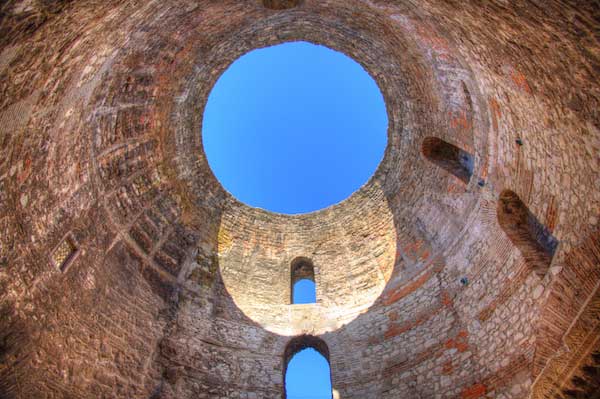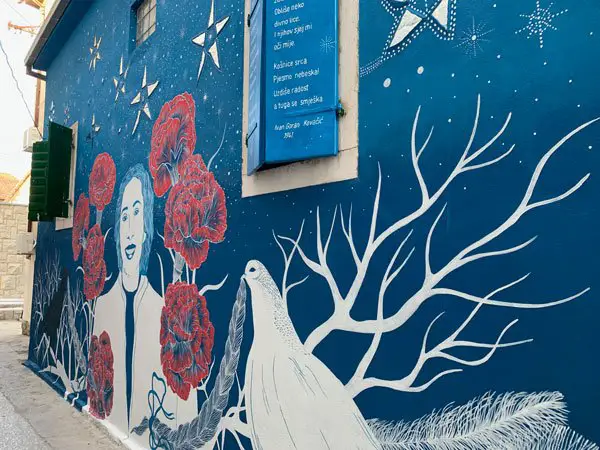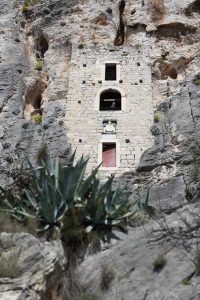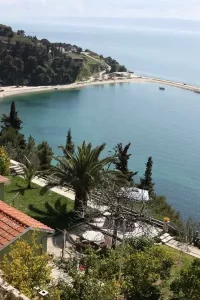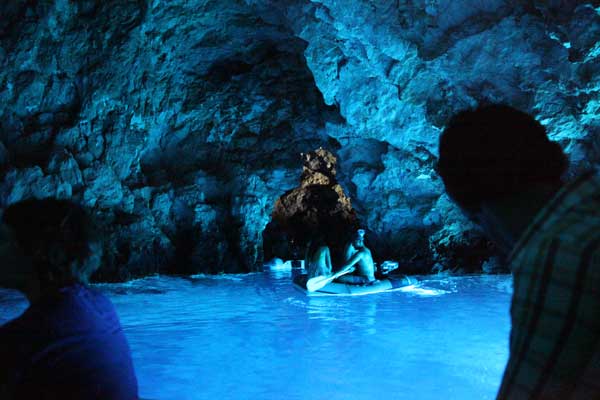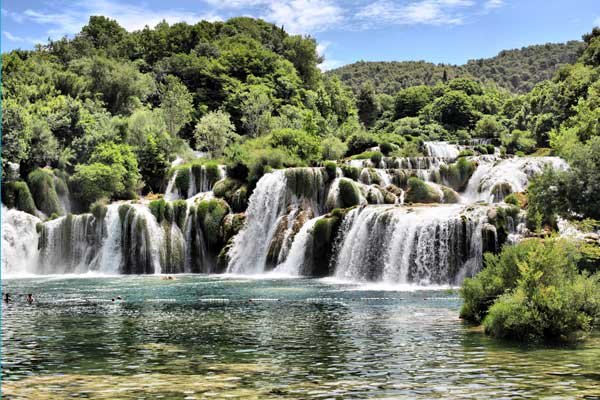Split’s tourist information website has lots of useful information on the city – including a calendar of events, places to see, a virtual walk and suggested itineraries – and the Tourist Bureau has official “Visit Split” offices on the Riva and in the Peristil square.
- The Palace & Grad – An Emperor's Retirement Home, Medieval Palazzo's and Waterfront Cafes
- Veli Varoš – The Charming Artisan Quarter around the Apartment
- Marjan – The Lungs of the City
- Beaches – Something for Everyone
- The Islands of Dalmatia
- Trogir and Further
- Eating Out in Split
- Bars & Cafes
- Useful Information
The Riva Waterfront – To See and Be Seen
The palm tree lined ‘Riva’ waterfront is the perfect place to enjoy a drink while watching Split’s beautiful people stroll by. With Diocletian’s Palace behind you and a view across to the islands of Brač, Hvar, and Solta, the Riva is hard to beat as a spot to while a few hours away at any time of day.
Peristil – The Centre of the Centre
Right in the middle of the palace itself is the public square which in Roman times was where the Emperor’s quarters met the public areas. Today, Peristil is a place where people come to marvel at the architecture, take a coffee, buy a trinket, listen to music or even, on certain nights, to dance. On one side of the Peristil is the cathedral of St Domnius (known locally as Sveti Duje) the building having originally been the mausoleum of Diocletian. Despite its tall bell tower it is easy to see its Roman heritage, not least because of the plundered Egyptian relics surrounding it. On the opposite side of the square is the Cafe Luxor, occupying a former Renaissance palazzo, beside which a tiny alley leads to the small but charming Temple of Jupiter. Between the cathedral and the Luxor is the Vestibule, which at the first floor level gives access to the buildings that once formed the Emperors private quarters, while some steep steps lead down to the palace basements where you will find stalls selling artwork and tourist momentos. Thanks to the great acoustics in the Vestibul, traditional Klapa singers practice and give ad-hoc concerts in it. You’ll hear them before you see them!
Pjaca – Where Old Friends Meet
On the west side of the palace is the square called Narodni Trg (known locally as Pjaca, pronounced piazza). This was the first area of expansion beyond the Roman palace and still houses the fifteenth century town hall and one or two other medieval buildings, sitting side by side with later, but still old, properties. Pjaca is known as a place where people, particularly the older generation, meet up for a coffee.
Pazar and Peškarija – Classic Mediterranean Markets
Split’s main food market – the Pazar – is just outside the east wall of the palace where a Roman horse track, the Hippodrome, once was. A classic market, Pazar serves up everything that local people and tourists alike could want. At the Riva end of the market are stalls selling tourist goods and clothes, along with a market for plants and fresh flowers. Further up is the ‘green market’ where farmers and gardeners from all over the area come, set up a stall, and sell their home grown fruit and vegetables or their home produced cheeses, smoked meats and honeys. These stalls are surrounded by permanent shops selling bread, pastries, meat and cheeses. The north end of the market has more stalls selling home wares, clothes and yet more food.
The Peškarija, or fish market, is on the opposite side of the Palace, off Marmontova Street. The location was chosen because the smell of sulphur from the neighbouring spa deters flies. The sulphur springs were one of the reasons why Emperor Diocletian, burdened by rheumatism, chose Split to build his Palace. Housed in a historic, purpose-built building, it’s an interesting place where you can see all the different types of seafood being traded.
Don’t Forget to Rub Grgur’s Toe
Just outside the northern gate of the Palace, the Zlatna Vrata, is a 8.5 metre tall statue of Bishop Grgur of Nin. Dating from 1929, the statue is the work of celebrated Croatian sculptor Ivan Meštrović. Local legend has it that if you rub the statue’s toe you will surely return to Split.
Palmina Piplović
The street the apartment is in ‘Palmina Ulica’ is thought to have been renamed after the second world war in honour of local resistance heroine Palmina Piplović. Aged only sixteen, Palmina was killed by the Nazis in 1944. A memorial to her is on the wall of a house down a small alley where Palmina meets Senjska.
St Nicholas’ Church
This perfectly formed little 11th century church sits tucked away in its own small square. Romanesque in style, it is sometimes open to visitors during the summer months.
The Videlica
At the top of the hill behind the apartment is a viewpoint (videlica in Croatian) which offers a superb outlook over the city and the islands. A cafe-restaurant operates out of a building that was once part of the Old Jewish Cemetery next door and serves drinks and food on its large terrace from which you can admire the great view. While the cafe has a formal title, almost no one knows it, referring simply to the ‘caffe videlica’. From here you can explore the Marjan peninsula.
Old Jewish Cemetery
Next to the Videlica cafe bar with its superb views over the city, is Split’s Old Jewish Cemetery. First established in 1573, the cemetery has over 700 graves. The last burial took place in 1945 when it was closed and protected as a monument. At one time Split had a sizeable Jewish population and its synagogue is one of the oldest in Europe still in use.
Ancient Churches
On the eastern slopes of the Marjan, just above the city, is the small, early thirteenth century church of St. Nicholas (Sv. Nikole). It’s no surprise that with its beautiful outlook across the water to the islands of Hvar and Solta that the church is dedicated to the sailors who ply the Adriatic. Two and a half kilometres further along the path that runs along the south rim of Marjan is the fifteenth century church of St Jerome (Sv. Jeronima). This features an equally lovely view over the islands and makes for a cool, quiet stop on any walk across the peninsula. The church has an altar carved by Andrija Aleši.
Homes for Hermits
Built into clefts in the cliffs directly above the church of St Jerome are a group of renaissance era hermitage caves, first used in the fifteenth century. Although not open for visits, it is easy to get a sense of what it might have been to be a religious hermit six hundred years ago. The inhabitants of Split have made pilgrimage to St Jerome since the early thirteenth century, possibly hoping to catch a glimpse of the self-exiled hermits!
Ivan Meštrović – A Great Sculptor
Thought by many to be one of the greatest sculptors of religious subjects since the renaissance, Meštrović was apprenticed to a Split master stone cutter and went on to become the first living person to have a one man show at the Metropolitan Museum of Art in New York City. His villa is now a gallery devoted to his work and its quiet location makes it a beautiful spot to appreciate the work on display.
Our map of Split’s beaches shows where each is in relation to the apartment.
The lively Bačvice beach, with its imported sand, and wide range of bars and cafes, attracts all those who want to see and be seen, or who want to play Glavomet or Picigin. Bačvice is only a 10-15 minute stroll from the apartment.
However, most Splicanis (natives of Split) think that the Marjan has the best beaches for swimming and sunbathing. These range from pebble beaches on the south side, to small un-named rocky coves on the north shore. The closest beaches on the south side can be reached on foot in 15-20 minutes or in minutes by using the regular bus service.
Ježinac and Kašjuni are wide pebble beaches and both have a couple of bar/cafes in summer.
Bene is a small resort at the end of the Marjan peninsula with a bar/restaurant, some attractions for children and a rock beach for swimming. It’s about 35-45 minutes on foot from the apartment through through the pine forests on the north side of the peninsula, and as you walk along you’ll see loads of small secluded bays where you can swim. Alternatively you can take a number 12 bus from Sv. Frane and arrive at Bene from the south side.
Brač, with its rocky ruggedness, makes a worthwhile day trip at any time of year due to the many daily ferry sailings, while Hvar’s quaint Starigrad and impressive Hvar town can also be visited in a day during the summer months. Korčula has a wonderful Venetian old town well worth seeing on a longer excursion and on Vis the charming village of Komiža has a relaxed pace and affords access to the Blue Cave on the nearby small island of Biševo.
Trogir is a UNESCO World Heritage site full of narrow alleys and Venetian architecture. It’s easily reached by coach or bus from Split and in the tourist season a Bura Line boat runs there from the Riva four times a day, stopping at the island of Čiovo on the way. It’s a nice way to travel to Trogir or back, or both
With a car it is also easy to reach Trogir, as well as a number of charming and historic coastal towns such as Primošten and Šibenik. Near the latter is the Krka Falls National Park where spectacular waterfalls race down a natural ravine. Our agent in Split offers day minibus excursions to Krka and several other attractions.
Further afield are the world heritage cities of Dubrovnik or Mostar (Bosnia & Herzegovina). Both are a heady mix of heritage and shopping opportunities and can be seen on a day trip using the fast inter-city coach service. But remember to take your passports if you travel to Bosnia and if you have a car you’ll need to check that its insurance covers you for the trip.
Eating Out in Split
Click on an address to open a Google Maps link.
Konoba Marjan, Senjska 1
Not only is this one of our nearest restaurants, but we also think it’s also the best in town! KM has a varied menu with superbly cooked fish centre stage. It’s very popular, especially in the evenings, so we would advise you to make a reservation if you plan to dine there.
Recommended : The Fish Plate for two people is to die for. Executive chef Marija also makes a great Black Risotto and a melt in the mouth Pasticada (slow cooked marinated veal).
Sperun, Sperun 3
Open all day and has a lovely ‘quirky’ feel. It can be very busy in the evenings.
Recommended: Brudjet (like a fish stew/soup) or Bakalar (traditional potato and salt cod dish)
Boom, Nigerova 2,
Superb traditional fish and meat dishes are served at this small outdoor restaurant just off Marmontova. Service is friendly and prices are very reasonable.
Bajamonti, Prokurative
Mazzgoon, Bajamontijeva ul. 1
Bokeria, Domaldova ul. 8
These three restaurants all serve modern European with a Dalmatian twist. Bajamonti has sea-view seating, Mazzgoon has a lovely enclosed courtyard at the back, ideal for warm evenings, and Bokeria has lots of space inside and some atmospheric alleyway seating.
Tri-Vaulta Aljesijeva Ulica
(Officially called the Diokletian Grill, but locals call it Tri-Vaulta on account of its three vaulted windows which are part of the palace wall.)
This small bar-come-restaurant is tucked away between the Peristil and the sea wall of the palace. One way to find it is to go to the Peristil and follow the little yellow signs marked ‘Grill’.
Recommended: Superb Prst i sir (pronounced ‘pruh-sut’ and ‘seer’) – locally smoked prosciutto & cheese served with bread.
ST Burek, Domaldova ul. 13
This little shop frequented by students sells burek, which are flaky pastries filled with cheese or meat. They are cheap eats that are good for eating on the move, although you can sit in if you want.
Bars & Cafes
Click on the address to open a Google Maps link.
If there is one place on earth where you are never more than five feet from a bar or cafe, it’s Split. Each of them has its own personality – sea views from the Riva, ‘look at me’ cafes in Pjaca or the Peristil, intimate bars in some of the small squares, or bo-ho meeting places in some of the back streets of the Palace. But our favourites are two that you may not come across without knowing about them:-
Cafe Videlica, Ilićev pro. 1
Go up the hill from Studio Loza and you will eventually reach this cafe bar with unbeatable views over the city. Great when it’s hot down below or when the sun is just going behind the Marjan and lighting the city up with a beautiful red glow. Videlica is a great stop off on a walk around the Marjan, or something to look forward to on your way back, and now serves breakfast and all day meals.
Cafe/bar at Sustipan.
Follow the road along the waterfront to the right of Sv. Frane and keep going until you reach the ACI Marina. Walk through this to headland and you’ll see the bar above you to your right. You’ll be rewarded with great views over the city and the islands, as well as cool breezes on a hot day. There is also a great little waterfront park with an old church just behind the cafe if you want some real peace and quiet.
Useful Information
Click on the address to open a Google Maps link.
Split Tourist Information Centre,
Obala Hrvatska Narodnog Preporoda 9
Tel: 021 348600 www.visitsplit.com
Jadrolinija – Ferries to the islands.
Gat Sv.Duje
Tel. 021 338324 www.jadrolinija.hr
Split Airport & airport transfers
Tel : 021 203589 www.split-airport.hr
If you prefer a private transfer we can arrange this (and at better rates than taxis!)
Promet (Split’s bus company)
Tel: 021 407999 www.promet-split.hr
Car Rental
We recommend: Economycarrentals.com
www.economycarrentals.com
Pharmacies (called Ljekarna in Croatian)
Ljekarna Matejuška (Not 24 hours), Trumbićeva obala 16, 021398529
Dobri (24 hours), Gundulićeva 52, Tel: 021 348074
Lučac (24 hours), Pupačićeva 4, Tel: 021 533 188
Markets
Pazar – Fruit, vegetables, meat, eggs, local produce. At the end of the Riva.
Fish Market – On Marmontova.
Supermarkets.
Studenac – Sperun 7. Local supermarket at the bottom of Senjska.
Spar – Šubićeva 5-7 Chain supermarket with lots of choice.
Launderettes
Modrulj Laundrette, Sperun 1
Self service, Service wash, bag storage.

